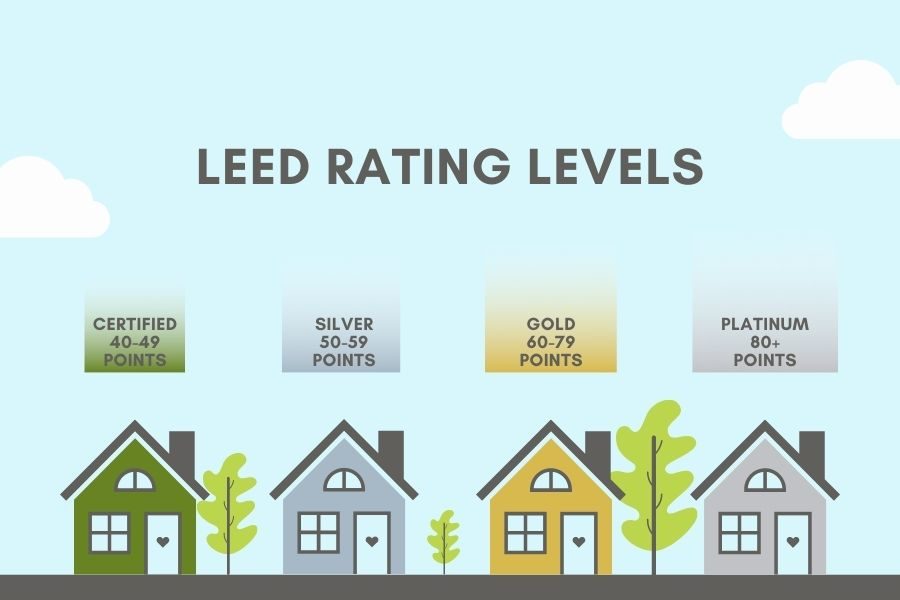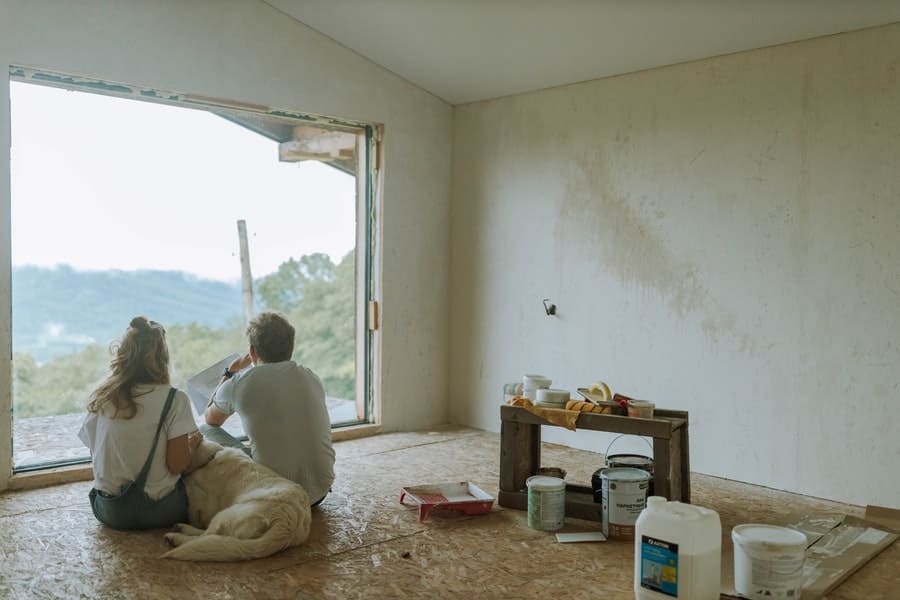LEED is not just for new construction; it is also implemented in existing residential projects using the new LEED v4.1 version. Maybe you want to start small; maybe your Home has a detached garage that you would like to renovate for use as a vacation rental. This is ideal because if your town is a destination place for many travelers, a LEED platinum rating would indeed serve as a differentiator when marketing your rental. (Below) continue reading so you can better understand other essential questions and factors for getting your home LEED Certified.
Related Vinyl plank flooring made simple: What you need to know
For more on vinyl plank flooring read the full article.
What Are The 4 Levels of LEED Certification?
There are four classification rating levels based on the number of points scored, ranging from certificate, silver, gold, and platinum. The platinum is the highest score, requiring 80 points or more.

How Does a Home Earn LEED Ratings?
Let’s look at ways a house could earn LEED ratings by reviewing some essential categories that you’ll see in a LEED scorecard for your Home, such as:
- Location and transportation: this includes proximity to various transportation options such as bike paths and public transit.
- Sustainable locations: this includes stormwater management using natural ground cover and protecting nearby habitat.
- Water efficiency: this includes reducing water use both indoors and outdoors and tracking water consumption through meters.
- Energy and atmosphere: this includes refrigerant management, energy metering, and energy efficiency optimization through renewable energy sources.
- Materials and resources: refers to construction techniques, which must use recycled or environmentally certified construction products, source raw materials locally or regionally, and reduce the amount of waste stored in landfills.
- Indoor environmental quality: includes aspects that affect air quality, lighting quality, acoustic design, and the environment, such as ventilation, use of low-emission materials, and use of natural lighting and heating.
The scorecard also rewards such things as innovation, adaptability, and regional or geographic priority areas.
Who Manage LEED for Home Program?
The LEED for Homes program is managed locally by LEED for home suppliers, your primary connection to the program. To start a team for the process, you call them first. First, I’ll introduce you to all the participants, and second, we’ll look at how they all work together from start to finish.
Suppliers make your certification process as easy as possible by providing administrative and technical support and preparing the final submission package for submission to the USGBC. Suppliers also oversee LEED’s verification services for homes green appraisers, i.e., individuals who come to the project site and ensure that the green measures are installed.
The green appraisers’ individuals also ensure that all home performance testing has been completed and meets LEED’s benchmarks. Your green appraiser can also help you understand the LEED for Homes program and be included in your project from the first phase of the new Home’s renovation or design.
One other person can be beneficial: a LEED-accredited professional specializing in the residential sector. A LEED-accredited professional with a housing specialty is an industry expert who has demonstrated expertise in residential green building and the LEED for Homes rating system.
Essential Factors to Consider Before Starting a LEED Project
It is necessary to create a working system. This should be active as early as possible during the pre-design phase of the project. Consider the following questions:
- What is the climate like at the project location?
- What type of heating and cooling system should be installed?
- Is there sufficient rainfall at the site to capture and use rainwater for irrigation?
- What are the project goals and requirements?
- How will the Home occupants move around once the project is completed?
- What are the public transportation options?
- How will building resources and materials be transported to the project site?
These are the types of questions that should be addressed during the earliest phase of the project. Therefore, the integrated process’s key is to integrate the entire project team to develop an efficient project design and enable the project team to discover strategies. Taking action late in the process will only result in delays and additional costs.
You can also note that most of the above questions depend on the location of the project. To turn project objectives into reality, a reliable assessment of the project location is mandatory. The project location should help the project teams rather than create challenges. If the sequence is vice versa, project teams must continue to search and discover ways to set project objectives, but they may also face more problems.
Understanding the entire community is also essential to the success of project integration. If people have to drive single-use vehicles to commute to a Home, the project will generate greenhouse gas emissions. The climate at the project location is another factor that will affect all building systems.
(For Home additions)The type of soil will also change depending on the location, which will, in turn, affect the entire structural calculation of the building and cause changes to the whole structural design. As with weak soil, a Home addition may need a deep foundation; however, this may not be the case with other soil types. Even the groundwater level of a given site can significantly impact the basement levels’ design and construction and the entire building.
When evaluating the site, it is always recommended to work with experts such as hydrologists, engineers, ecologists, and project development consultants. At the beginning of the project, project teams should assess:
- Local and zoning codes.
- International Code Council (ICC) standards.
- Americans with Disabilities Act (ADA) requirements.
- All other applicable laws for that location.
Lets now summarize the main principles of the rules of the integrated process that the project team should follow:
- Process matters: in other words, the system must run efficiently.
- Start early: This means that the system must be active as soon as possible.
- Follow-up: This means that the engagement should continue throughout the project’s life and should not end with completing construction. Doing this will ensure that the project strategies are maintained and that all building systems remain efficient during the Home’s operational phase.
- Look beyond upfront costs to save in the long run: green strategies have brief payback periods. The project team should inform project stakeholders that their project will cost less in the long run.
- Include and collaborate: the professional project team should work together with community members and always look at the big picture, and establish a working system between project team members, stakeholders, and community members, an iterative process needs to be developed.
How to Start LEED for Home Certification Process
Once you have decided to start the process to get your Home LEED-certified, go to www.usgbc.org/homes to select a LEED for Homes suppliers. You can work with any supplier listed on the US Green Building Council website and directly contact your supplier. At this stage, you will want to inform the project team that will design and renovate/build your Home. The project team will work with your supplier to conduct a preliminary rating. At this meeting, you will create an action plan that identifies:
- The level of LEED certification chosen.
- Which home LEED credits you have chosen to work on.
- Who on the team is in charge of each credit.
This essential step ensures that everyone agrees on the main objectives of the project. After receiving your supplier’s approval, you will need to register your project directly with the US Green Building Council by visiting their website. Once the project is registered and you plan to rent or sell your Home, you can begin marketing your green building intention with the LEED for homes logo.
What to Do During The LEED Renovation/Construction?
During the renovation/construction phase, it is essential to maintain close contact with the green appraiser. The green appraiser will visit the project site at least once during renovation/construction and again after the project completion. With the project team’s support, the green appraiser will verify that the prerequisites and selected LEED measures are meet and that the required performance tests are performed.
What Happens After Final LEED Inspection?
After the final LEED inspection, your green appraiser prepares the project documentation, which includes:
- The final LEED for Homes project checklist.
- The completed and signed responsibility forms.
- The finished and signed durability assessment form.
- The durability inspection checklist.
The green appraiser delivers the submitted package to the supplier, who, upon review, transmits it to the USGBC. USGBC certifies the homes through a third-party review and notifies the supplier upon certification. You will receive a certificate and marketing tools to promote your project.
Again, these marketing tools are great if you plan to rent or sell your Home as a genuinely green option to your prospective tenants or buyers. The USGBC can help you write a press release and make other suggestions on promoting your project.

